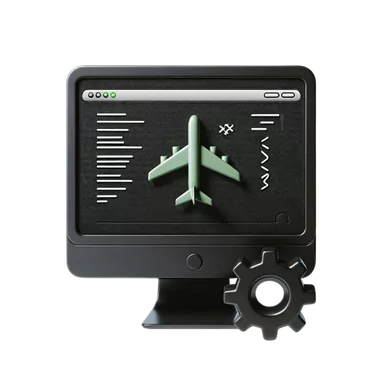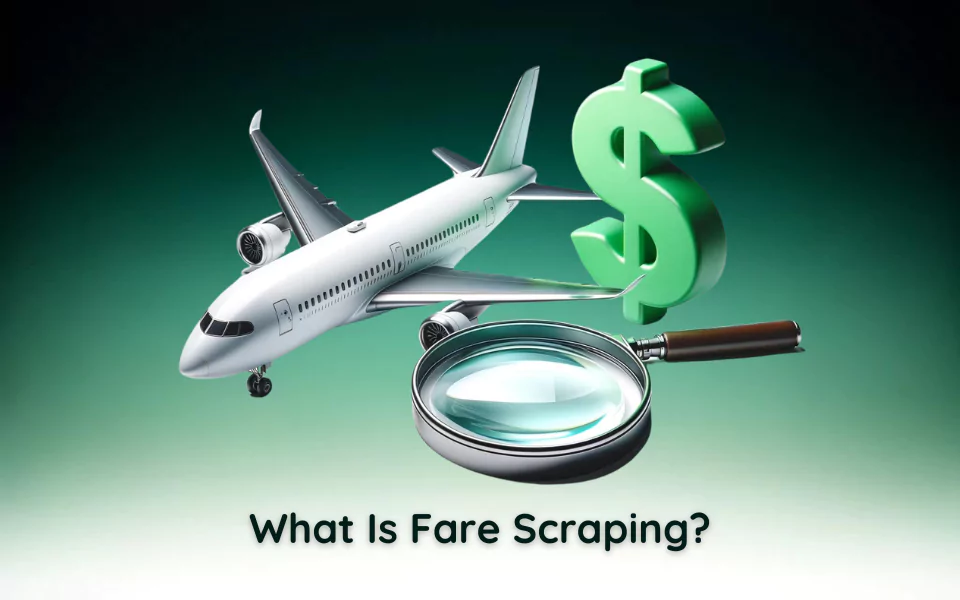Are you a travel company looking to gain a competitive advantage? Or perhaps a data-savvy traveler seeking hidden deals and unpublished flights? Flight fare scraping might be your secret weapon. By extracting real-time pricing information, you can use tools like fare scrapers to outsmart the competition.
Learn the ins and outs of fare scraping – from understanding website structures to all the tools you need to collect price data – and discover how to stay a step ahead in the dynamic world of air travel pricing.
We Covered Instagram Scraping, Facebook Scraping, WhatsApp Scraping, Google Search Scraping, LinkedIn Scraping, and Amazon Scraping in previous guides. Today: It’s a new guide you will love.
Table of Contents
- What Is Ticket Fare Scraping For Flights?
- Why Is Fare Scraping A Game Changer?
- Who Needs Air Flight Fare Scraping?
- How Does Fare Scraping Technically Work?
- Why Do Your Fare Scraping Efforts Need Proxies?
- Dissecting Travel Websites for Data
- Best Fare Scraping Tools In 2024
- Can I Build My Own Flight Price Tracker Using Python?
- Is Fare Scraping Legal?
What Is Ticket Fare Scraping For Flights?
Fare scraping is the automated process of extracting pricing and flight data from airline and travel aggregator websites. This powerful technique offers numerous advantages, including:
- Price Monitoring: Track real-time price fluctuations to identify the optimal time to book flights.
- Market Research: Gain valuable insights into market trends, pricing strategies, and route popularity.
- Competitor Analysis: Monitor competitors’ pricing and offerings to make informed business decisions.
Why Is Fare Scraping A Game Changer?
Fare scraping revolutionizes how we find affordable flights and conduct travel-related business. Here’s why:
- Real-Time Advantage: Unlike manual price searches, fare scraping provides up-to-the-minute data, empowering you to act on the best deals before they disappear.
- Automation Saves Time: Eliminate hours spent on multiple websites. Scrapers tirelessly collect data while you focus on analysis and decision-making.
- Informed Decisions: Data-backed insights from fare scraping replace guesswork, driving smarter booking strategies and competitive pricing.
Who Needs Air Flight Fare Scraping?
Flight fare scraping benefits a surprisingly wide range of individuals and businesses. Here’s a breakdown of who stands to gain the most:
- Price-Conscious Travelers: Whether you’re on a tight budget or simply want the best deal, fare scraping helps you identify the cheapest flights and discover potential “hidden” or unpublished fares.
- Travel Agencies & Aggregators: Stay ahead of the curve by constantly monitoring competitors’ prices. Fare scraping allows you to adjust your offerings dynamically and provide customers with the most attractive deals.
- Airline Companies: Analyze market trends, route popularity, and competitor pricing to optimize your own pricing strategies and flight schedules.
- Market Analysts: Gather large-scale airfare data to track pricing patterns, predict fluctuations, and gain insights into the broader travel industry.
- Developers: Fare scraping projects are an excellent way to practice web scraping skills, build price tracking tools, or create innovative travel-related applications.
In short, if you’re involved in any aspect of air travel where real-time pricing data offers a competitive edge, fare scraping is a tool worth exploring.

How Does Fare Scraping Technically Work?
At its core, fare scraping involves these main steps:
- Step 1: Identifying Target Websites: Decide which airline or travel aggregator websites (e.g., Expedia, Skyscanner) contain the pricing information you need.
- Step 2: Analyzing Website Structure: Examine the website’s HTML code to pinpoint where the flight and fare data reside. Look for specific tags and patterns that consistently hold the desired information.
- Step 3: Sending Requests: Your fare scraper simulates a web browser, sending HTTP requests to the target website to retrieve the pages containing the fare data.
- Step 4: Extracting the Data: The fare scraper parses the HTML response, using the structural knowledge you gained in step 2. It isolates the relevant flight details and prices.
- Step 5: Storing and Organizing: The extracted data is neatly saved into a usable format, such as a spreadsheet, database, or JSON file for further analysis.

Why Do Your Fare Scraping Efforts Need Proxies?
Finding flights at the best prices means having data you can trust. If your fare scraper constantly gets blocked or delivers inconsistent results, it’s costing you time and money. Let’s learn how proxies make your scraping efforts more accurate and reliable:
- Bypass IP Blocking: Travel websites often track user activity. Sending too many requests from a single IP address quickly gets you flagged and blocked. Fare Scraping Proxies rotate your IP address, making your scraper look like multiple real users accessing the site naturally.
- Access Geo-Restricted Fares: Some airlines and aggregators adjust pricing based on your location. Proxies let you “appear” to be browsing from different countries, potentially unlocking better deals.
- Maintain Anonymity: If anonymity is important, proxies mask your real IP address, offering an additional layer of privacy.
- Handle Large-Scale Scraping: For ambitious data collection projects, you need multiple IPs working in tandem. V6Proxies web scraping proxies enable this without triggering anti-scraping measures.
Residential vs. Datacenter Proxies for Fare Scraping
While both residential and datacenter proxies help, residential proxies often have the edge for fare scraping:
- Residential Proxies: These use real IP addresses from home internet users, appearing as genuine, individual browsers – the kind travel websites welcome.
- Datacenter Proxies: While fast and affordable, datacenter IPs are easier to spot by anti-scraping systems since they’re not associated with residential addresses.
The Bottom Line: To maximize the efficiency and success of your fare scraping, investing in high-quality residential proxies is a wise strategy.
Looking for reliable residential proxies to power your fare scraper? Explore our web scraping proxies for the best results.
Dissecting Travel Websites for Data
Think of a travel website like a neatly arranged storefront. Your fare scraper needs to understand the layout to find the ‘items’ (flight data) you want. This involves:
- The Power of Your Browser’s Developer Tools: Right-click on any price or flight detail on a travel website, and select ‘Inspect element’. This gives you the underlying HTML code.
- Finding Patterns: Examine the HTML to spot tags and classes consistently surrounding the desired data. For instance, flight prices might be within a <div> tag with the class “fare-price”.
- Mapping Your Scraper’s Strategy: Use your discoveries to guide your scraper. Instruct it to search for specific HTML patterns and extract the data within them.
Example
Let’s say you want to scrape flight durations. Your inspection might reveal that durations are always enclosed like this:
HTML
<span class=”flight-duration”>2h 35m</span>
You’d tell your scraper to locate all <span> elements with the “flight-duration” class, and to grab the text content within.
Important To Remember:
Website structures change over time. Monitor your scraper to adjust if layouts shift.
Best Fare Scraping Tools In 2024
For successful fare scraping, choosing the right tool is crucial. Look for features like speed, reliability, and accuracy in data extraction. Integration with proxies is also important to bypass IP blocking and access geo-restricted fares.
Popular fare scraper tools include:
1. ScrapeStorm:
Ideal for non-coders, ScrapeStorm is an AI-enabled visual scraping tool that requires no coding. It is effective for scraping a variety of websites, including travel-related ones like Expedia. It offers a free starter plan with limitations and paid plans starting at $99 per month.
2. WebScraper.io:
This is a free browser extension for Chrome that provides an easy-to-use point-and-click interface for scraping data, including travel fare information. It’s suitable for scraping dynamic websites and requires no coding. WebScraper.io is particularly useful for those looking for a free tool.
3. ParseHub:
This is a free web scraping tool that is user-friendly and capable of extracting data from complex web elements like forms and pop-ups. It’s particularly effective for parsing JavaScript-heavy sites and offers features like IP rotation and scheduled data collection.
4. Webz.io:
Webz is a powerful tool for extracting enterprise-level, real-time data from online resources. It offers structured data with sentiment and entity recognition and is capable of scraping data from various sources including news, blogs, and forums. This tool is particularly useful for large-scale scraping tasks.
5. Scrape.do
This tool provides access to a vast network of proxies, making it suitable for scraping data from websites with strict restrictions. It offers features like rotating proxies, geotargeting, and CAPTCHA bypassing, which are essential for scraping travel fare data.
Related: Best Web Scraping Proxies in 2024

Can I Build My Own Flight Price Tracker Using Python?
Yes, Building your own flight fare scraper is indeed possible, especially if you have some familiarity with programming, particularly in Python. To create a flight fare scraper, you can use Python libraries such as Selenium for web automation and BeautifulSoup or LXML for parsing HTML data. Here’s a general outline of the steps involved:
- Setup: You’ll need to set up a Python environment and install necessary libraries like Selenium, LXML, or BeautifulSoup. Selenium will help you automate web browser interaction, which is essential for accessing and navigating flight booking websites.
- Web Browser Automation: Using Selenium, you can automate tasks like entering search criteria (departure and arrival locations, dates, etc.) on a flight booking website. For example, you can use Selenium to select the departure and arrival countries, input travel dates, and initiate a search on the website.
- Data Extraction: Once the search results are loaded, you can use BeautifulSoup or LXML to parse the HTML content of the page. You’ll extract relevant details like flight times, prices, airlines, duration, and more.
- Data Compilation: After extracting the information, you can compile the data into a structured format like a Pandas DataFrame. This structure makes it easier to analyze or save the data, possibly into an Excel file or a database.
- Error Handling: When building a scraper, it’s crucial to include error handling to deal with issues like changes in the website’s layout or unexpected webpage behavior.
More Resources
For a more hands-on approach, you can look into existing GitHub projects that provide insights into building flight fare scrapers. One such project is flight_scraper, which polls ITA Matrix Airfare Search and Flightstats for seat availability and price fare information. This project aims to correlate seat availability with pricing trends and includes a range of dependencies such as Requests, MongoDB, Flask, and Selenium.
Is Fare Scraping Legal?
The legality of fare scraping can be complex and varies based on several factors, including the methods used for scraping, the type of data being scraped, the purpose of the scraping, and the jurisdiction.
In some instances, fare scraping can lead to legal disputes, especially if it violates the terms of use of a website. For example, Southwest Airlines filed a lawsuit against Kiwi.com for unauthorized scraping of flight and pricing data, asserting multiple legal claims including breach of contract and violations of the Computer Fraud and Abuse Act (CFAA). This case highlights how companies may take legal action against scraping activities that they believe infringe on their rights or violate their terms of service.
In summary, while web scraping, including fare scraping, is a common practice in many industries, it’s essential to consider the legal aspects and ensure compliance with relevant laws and website terms of use.
Related:
- Tags:
- python, web scraping




